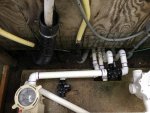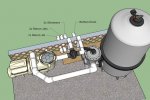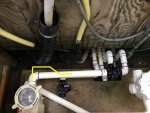I spent all day Saturday redoing my plumbing... and now I'm going to have to re-do it all over again. Not necessarily because of the 90 degree elbow into the pump, but because I accidentally used all dwv rated couplers and elbows  . I figured all of this out when I went to read the wiring guide for my new pump and saw the notice "do not install a 90 degree eblow directly into pump intake" which led me to research on this site, which led me to have trouble falling asleep thinking about the waste of the day and money. Worst part is I wasted $80 in 2 jandy valves because I glued a 90 degree dwv onto each of them already.
. I figured all of this out when I went to read the wiring guide for my new pump and saw the notice "do not install a 90 degree eblow directly into pump intake" which led me to research on this site, which led me to have trouble falling asleep thinking about the waste of the day and money. Worst part is I wasted $80 in 2 jandy valves because I glued a 90 degree dwv onto each of them already.
All that aside, how crucial is avoiding the 90 degree elbow into the pump? I say that because I'd have to turn the pump (which I've already drilled into the concrete) and reconfigure my piping plan because I can't fit any sort of straight pipe into the pump how I wanted to lay it out. Pentair 011581 WhisperFlo 1-1/2 HP
All that aside, how crucial is avoiding the 90 degree elbow into the pump? I say that because I'd have to turn the pump (which I've already drilled into the concrete) and reconfigure my piping plan because I can't fit any sort of straight pipe into the pump how I wanted to lay it out. Pentair 011581 WhisperFlo 1-1/2 HP




